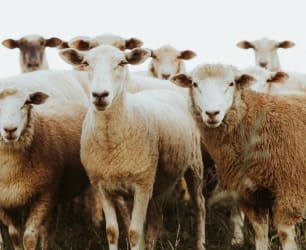SHEEP and shearing go hand in hand. Both are ingrained in the national psyche in films and art such as Tom Roberts’ 1890 Shearing the Rams painting or the 1975 film Sunday Too Far Away that propelled Jack Thompson into acting royalty.
These days those in the business say a strong demand for shearers persists, and with numbers of sheep expected to increase while that of shearers decreases, plenty of room exists for people – female and male – wanting to break into the industry.
Shearer Woolhandler Training tutor Matt Stasinowsky, who gave school students tips on shearing at this year’s Karoonda Farm Fair and Show, said both wool handling and shearing were valuable careers.
“The wool handling side of it, you can normally learn the skills in a day, and be competent at your job, but the shearing sort of takes quite a few weeks to learn the skills and get your body in the right condition to handle the work,” Mr Stasinowsky said.
“It is very physical, you certainly need to be fit in body and mind, but it is something that most people could do.
“We get a lot of females learning to shear.
In the last five years there has been an increase in the women having a go (while) the wool handling side has always been mainly women.” Mr Stasinowsky said one of the attractions of working as a shearer or wool handler was the chance to travel.
In pre-COVID times Australian shearers were able to work right across Australia, into New Zealand and even in Great Britain and Europe.
“Because you are at the one place for a week or two at a time, you are always moving around meeting different farmers and people all the time,” Mr Stasinowsky said.
“The wool handling pays about $65 a run, and a run is two hours, so that works out to be about $33 an hour.
“As a shearer you get paid per head.
The average shearer would shear about 150 a day, (and) the award is about $3.20 per head at the moment.
“Certainly many farmers will pay you more than the award.
If you are doing the job well they will pay that bit extra (and for example) in the last few years we have had dry years and the sheep have had a lot of sand in them and been a lot harder to work with, so the farmers paid that bit more.” Pinnaroo farmer Bill Venning spent 25 years working as a shearer locally, and recommends it as a job for young people.
“I think a lot of young fellas should learn to shear just for the mateship, and getting around the country side,” Mr Venning said.
“I enjoyed shearing. I probably didn’t do big numbers like a lot of them, the most I did in a day was 160, but I enjoyed going out to different sheds and working with different people.
“Working as a team is always a fair bit in front of working on your own.
“The team side of it was always appealing, and I wasn’t much of a competitor – if someone was faster than me I let them go, there’s always plenty of room out the front.” Mr Venning said these days measures could be put in place to decrease the impact on a shearer’s back.
“I heard a medical person say that as long as a person uses a back aid, these days shearing is a very physically healthy sport,” he said.
“When you get shear fit, you are so flexible, and it is really an energetic and physical job.” Shearers often try their hand at shearing competitions held at events such as the Karoonda Farm Fair and the Pinnaroo Show and Field Day – something Mr Venning still enjoys when he competes in the veteran class.
Mr Stasinowsky recommends prospective shearers and wool handlers combining a course like those available at Shearer Woolhandler Training with on-the-job learning.
“There is a shortage, and sheep numbers will only increase if we get some more good seasons,” Mr Stasinowsky said.
“Last year, because we couldn’t get the interstate or overseas workers, we had a lot more learners coming through the program.
“And because a lot of shearing sheds had empty stands there was ongoing work for those learners to go into.
“Previous years farmers or contractors found it hard to take on a learner because their teams were already full, (and) because a learner is a bit slower they tended not to take them on.
“But last year there was a shortage of shearers and the learners were getting a job straight away.” Shearer Woolhandler Training is running a novice shearing and wool handling school in Pinnaroo from June 21 to June 25, and another course in Karoonda in August.
Details can be found on its Facebook page.






